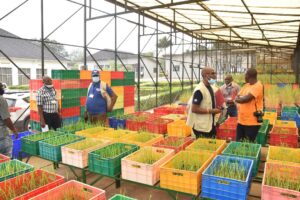
For many years, rice has been an important part of Sri Lankan culture and it is also the country’s invaluable and most accessible food source. On average, each Sri Lankan consumes 115 kilograms per year. Despite the country’s flourishing rice industry, a field enemy has been taking farmers paddies by storm.
This enemy is weedy rice. It resembles cultivated rice, except for some characteristics.
Some weedy rice species bear a scrawny awn that starts to develop after only 2–3 seasons and these awns appear in the stages just before the grains start to appear; others have grains that come off easily when touched but most weedy rice species don’t mature uniformly in the field.

“To date, we have identified more than 1,500 types of weedy rice,” says Anurudhika S.K. Abeysekara, a weed expert from the Rice Research and Development Institute(RRDI) in Sri Lanka.
“The first time I saw weedy rice was in 1992, but, back then, it was not a problem,” shares Ms. Abeysekara. “At that time, we had identified only 7–8 types of weedy rice. Then, in the early 2000s, we noticed that the problem started to worsen.”
A rice impostor
In 2005, a local TV station reported that farmer D. Rajapakse claimed to have found a “miracle rice variety” that could produce 120–150 panicles. (Panicles are the flowering part of the rice plant where grains are formed.) Regular rice has only 3–10 panicles depending on the cultural method used, making the “newly found rice” appear to have much higher yield potential.
“That media report surprised me because I’ve never heard of a rice variety that could produce as many as 150 panicles, so some RRDI staff and I visited the farmer to see the crop ourselves,” says Ms. Abeysekara.
“Indeed, it was no miracle rice variety—just weedy rice,” she adds. “So, we had the media report corrected. And then we advised the farmers to pull out any weedy rice in their fields.”
The grains of weedy rice have poor eating quality and fall to the ground easily. Also, weedy rice has lower yield after the first and second seasons.
Since its grains easily fall to the ground, weedy rice has no trouble multiplying itself in the soil. Therefore, it may take 3–4 years of weeding and good land preparation to clear the land thoroughly.
Field recovery
Farmer D. Rajapakse spent 5 long years removing weedy rice from his field. He tried many approaches to clear his land of weedy rice.
Initially, he tried seed broadcasting; then, he also used a drum seeder, transplanting, and parachute sowing among other techniques.
“Transplanting,” he says, “was costly because the labor wage rate was 600–700 Sri Lankan rupees (US$4–5).” For Mr. Rajapakse, parachute sowing was the best among all the approaches he tried.
“A clean source of seed is very important to avoid re-planting weedy rice plants for the next season,” says Dr. Nimal Dissanayake, RRDI director and national coordinator for the International Rice Research Institute (IRRI) activities in Sri Lanka.
No lost cause
“We can stop this weedy rice problem but we have to educate the people first,” says P.V. Hemachandra, RRDI rice breeder. “Many farmers don’t like to pull out weedy rice from their fields because they’re thinking it’s still rice.
“Moreover, farmers don’t like to go into their fields during heading stage or grain-filling stage when they have a better chance of telling apart cultivated rice and weedy rice,” he adds. “It is their traditional belief that going to the field at that time will ruin any developing grain.”

“It’s very difficult to convince them,” narrates extension officer Dilhan Wickramasinghe. “Only 25% of the farmers follow our instructions but, with demonstrations, we can change their ideas or perceptions because they are able to see things for themselves.”
“We carried out a total of 200 awareness programs in the previous years,” cites Ms. Abeysekara.
“Awareness programs on weedy rice are relatively good even if our present extension system is limited,” notes Swarna Herath, an assistant of Ms. Abeysekera in the weedy rice project. “But, because of media such as radio and TV, awareness is slowly building up.”
“This weedy rice is really a green menace, but no miracle will easily remove it from farmers’ fields—only practical community action and smarter strategies will do,” says IRRI weed expert Dr.Bhagirath Chauhan.
In 2011, he conducted trials in different parts of Sri Lanka to study the effect of different crop establishment methods on weedy rice. Visually, results showed that weedy rice was less rampant when wet seeding was done with a drum seeder compared with broadcasting seeds.
He also introduced mechanical seeders in Sri Lanka so that farmers can plant rice much faster and easier, in rows. With this method, farmers can better spot weeds, especially those that closely resemble rice so they can be pulled out.
Dr. Chauhan also conducted a seminar and demonstration on mechanization with farmers in one district. “The chief engineer from Kandy said that although rice harvesting in Sri Lanka was already quite mechanized, seeding, on the other hand, was not, and that it was the first time mechanical seeders were brought to Sri Lanka,” he shares.






